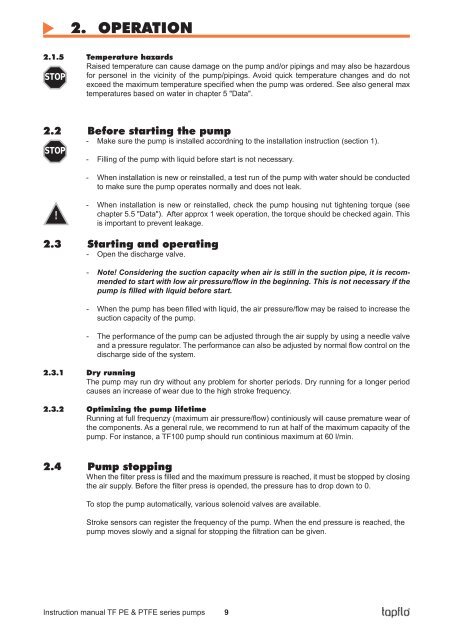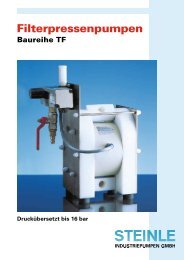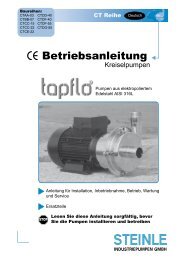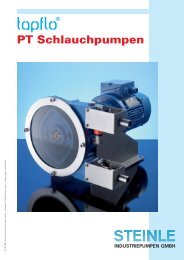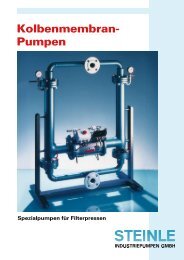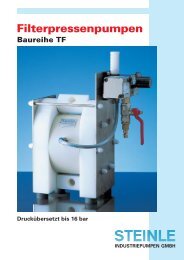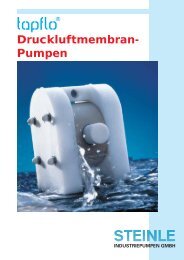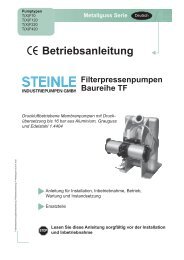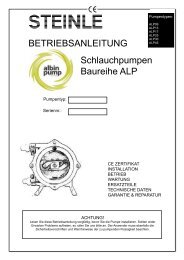EC declaration of conformity
EC declaration of conformity
EC declaration of conformity
You also want an ePaper? Increase the reach of your titles
YUMPU automatically turns print PDFs into web optimized ePapers that Google loves.
2. OPERATION<br />
2.1.5 Temperature hazards<br />
Raised temperature can cause damage on the pump and/or pipings and may also be hazardous<br />
STOP for personel in the vicinity <strong>of</strong> the pump/pipings. Avoid quick temperature changes and do not<br />
exceed the maximum temperature specified when the pump was ordered. See also general max<br />
temperatures based on water in chapter 5 "Data".<br />
2.2 Before starting the pump<br />
STOP<br />
!<br />
- Make sure the pump is installed accordning to the installation instruction (section 1).<br />
- Filling <strong>of</strong> the pump with liquid before start is not necessary.<br />
- When installation is new or reinstalled, a test run <strong>of</strong> the pump with water should be conducted<br />
to make sure the pump operates normally and does not leak.<br />
- When installation is new or reinstalled, check the pump housing nut tightening torque (see<br />
chapter 5.5 "Data"). After approx 1 week operation, the torque should be checked again. This<br />
is important to prevent leakage.<br />
2.3 Starting and operating<br />
- Open the discharge valve.<br />
- Note! Considering the suction capacity when air is still in the suction pipe, it is recommended<br />
to start with low air pressure/flow in the beginning. This is not necessary if the<br />
pump is filled with liquid before start.<br />
- When the pump has been filled with liquid, the air pressure/flow may be raised to increase the<br />
suction capacity <strong>of</strong> the pump.<br />
- The performance <strong>of</strong> the pump can be adjusted through the air supply by using a needle valve<br />
and a pressure regulator. The performance can also be adjusted by normal flow control on the<br />
discharge side <strong>of</strong> the system.<br />
2.3.1 Dry running<br />
The pump may run dry without any problem for shorter periods. Dry running for a longer period<br />
causes an increase <strong>of</strong> wear due to the high stroke frequency.<br />
2.3.2 Optimizing the pump lifetime<br />
Running at full frequenzy (maximum air pressure/flow) continiously will cause premature wear <strong>of</strong><br />
the components. As a general rule, we recommend to run at half <strong>of</strong> the maximum capacity <strong>of</strong> the<br />
pump. For instance, a TF100 pump should run continious maximum at 60 l/min.<br />
2.4 Pump stopping<br />
When the filter press is filled and the maximum pressure is reached, it must be stopped by closing<br />
the air supply. Before the filter press is opended, the pressure has to drop down to 0.<br />
To stop the pump automatically, various solenoid valves are available.<br />
Stroke sensors can register the frequency <strong>of</strong> the pump. When the end pressure is reached, the<br />
pump moves slowly and a signal for stopping the filtration can be given.<br />
Instruction manual TF PE & PTFE series pumps 9


